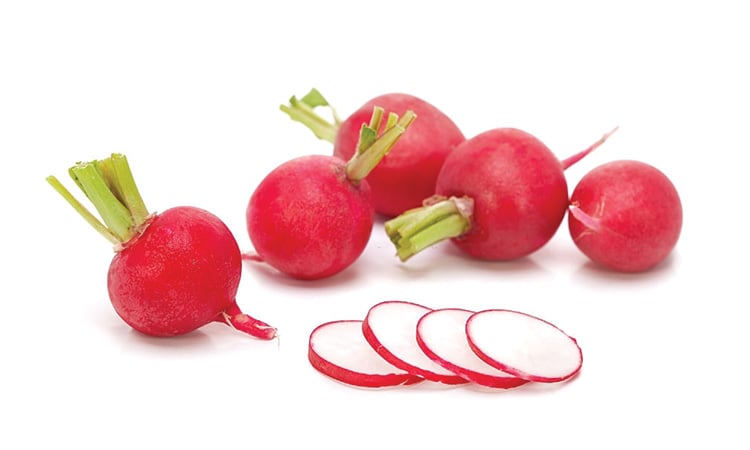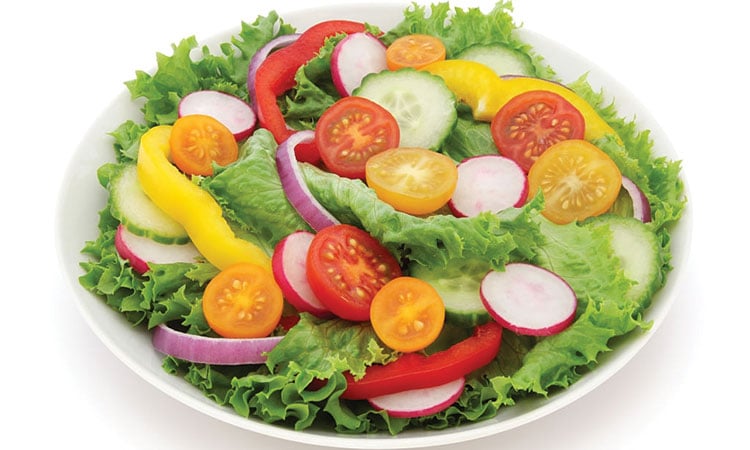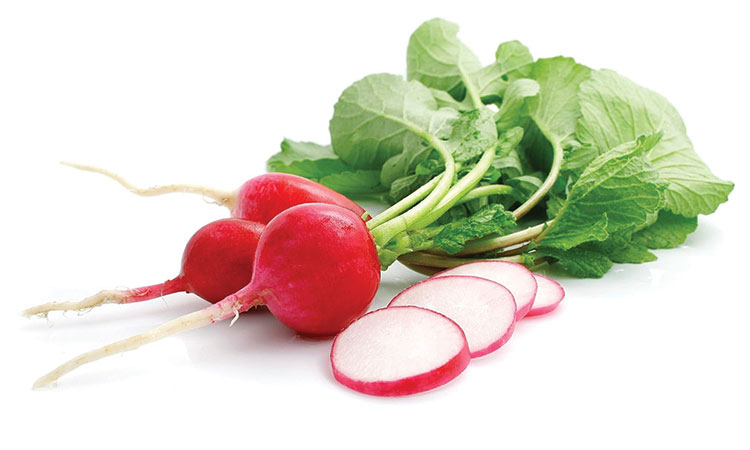Radish is one of the most loved winter root vegetables. It has a high nutrition value and also has many medicinal properties. However, when it comes to the question “Radish during pregnancy- is it safe,” well, it is safe only if you follow certain precautionary measures.
Not only the root, but the flowers, leaves, and young pods of this winter root are edible. Due to its medicinal properties, this root vegetable is even used in many Ayurvedic and Traditional Chinese Medicine to treat many conditions such as fever, cold, sore throat, gall bladder stones, cough, etc.
Irrespective of all these qualities, radish during pregnancy can pose danger during pregnancy. The danger is not direct, though. Radish intake during pregnancy is unsafe only if eaten or prepared in the wrong way.
Types of Radish
Radish comes in all kinds of colors, shapes, and sizes. It can be big or small, short and round, or oblong or long with tapering ends.
The color of radishes ranges from pure white to black. It also comes in rosy pink, reddish-purple, light green, and even black.
Likewise, the flavor of radish also varies with variety. It ranges from mild to sharp and spicy.
Is It Safe To Eat Radish During Pregnancy
Without proper care and precautionary measures, eating radish during pregnancy is not safe.
Pregnancy is a crucial time. One wrong move can put the developing baby and progressing pregnancy at stake. Many a time what you consume during pregnancy can have an instantaneous effect on pregnancy.
Calculate Due Date With LMP
There is no direct danger of eating radish during pregnancy. However, it has a major indirect effect that can hamper the normal progression of pregnancy.
The danger is associated with possible food contamination.
Radish is a root vegetable. When it comes to eating root vegetables during pregnancy, the soil in which they are grown and how they are grown (is there any overuse of chemical fertilizers/ pesticides, etc.) matters.
Studies show crops, especially root crops, that are grown in contaminated soil are more at risk of carrying Toxoplasma gondii, parasites that can cause toxoplasmosis. Radish that is grown in contaminated soil is more at risk of carrying this germ.
These germs can get into expecting women’s womb when they consume raw vegetables. Once inside, these germs can cause a dangerous infection- toxoplasmosis.
As the immunity level of pregnant women is pretty low, she is more at risk of contracting this infection.
According to studies, pregnant women contract toxoplasmosis it can end up in miscarriage, stillbirth. In extreme cases, this infection could potentially damage the baby’s brain and other organs, more often, the eyes.
Nutritional Benefits Of Eating Radish During Pregnancy

Radish is highly nutritious and carries several vitamins and minerals highly beneficial for the mother and the developing baby. It contains a considerable amount of vitamin C and folate. Both are highly beneficial for the healthy development of the fetus.
It also contains calcium, which is very essential for both mother and child. It also contains other vital nutrients that are highly beneficial for pregnancy such as potassium, iron, zinc, and manganese. It also has riboflavin, vitamin K, copper, and vitamin B-6.
Here `are some amazing benefits of radish during pregnancy.
- Being low in carbohydrates and high in fiber, radish helps to combat constipation and curb hunger pangs during pregnancy
- Potassium in radish helps to improve blood circulation and bringing down blood pressure.
- Radishes have diuretic properties. This improves the production and flow of urine. This will bring down the risk of UTI (urinary tract infection), which is common during pregnancy.
- Expecting mothers are prone to respiratory infections, colds, and allergies. The anti congestive property of radish helps to prevent the irritation of the respiratory tract that includes the nose, throat, windpipe, and lungs.
- The low glycemic index of radish makes one person feel full without affecting blood sugar level. It is therefore highly beneficial for an expecting mother who has gestational diabetes.
- Pregnancy is a time many mothers experience various skin issues like dry skin. This underground vegetable contains Vitamin C, B vitamin, zinc, and phosphorus which are excellent for the skin.
Are There Any Side Effects Of Eating Radish During Pregnancy?

Despite all the benefits mentioned above, if not properly washed and cooked, eating radish during pregnancy can bring about several side effects, some of which are harmful to the mother and unborn child.
Eating raw radish during pregnancy makes the mother prone to Salmonella and E.Coli infections. This can have harmful effects on the mother. It can also adversely affect the health and development of the baby in the womb.
Likewise, overconsumption of radish during the pregnancy can trigger some harmful side effects. Eating too much radish may increase the risk of dehydration due to its diuretic property.
Including too much radish in the pregnancy diet can also bring about low blood pressure and hypoglycemia (low blood sugar). Both of these conditions can bring about many pregnancy complications. It is also said to stop radish intake before a scheduled surgery.
It is found that pregnancy contributes to the development of gallstones. Radish if eaten in excess by expecting women who gas gall stone issues can aggravate the problem. This is because the radish increases the flow of bile. And as the gall stone blocks the bile duct, this sudden surge of bile cause sudden pain and discomfort.
Safety Measures to Follow While Eating Radish
The nutritional value of radish can be utilized during pregnancy. However, it is important to follow certain precautionary measures before including radish in the pregnancy diet. All these hygiene practices reduce the risk of infection.
- First of all, wash the root vegetable thoroughly. Removing dirt is very important to prevent possible infection. Start washing radish under running water. Use a stiff brush to scrub away all the visible dirt from the surface. After that, use some warm water and soap to wash the radish. Again, bring it under running water.
- You can also peel the skin after the washing process. When it comes to pregnancy, it is okay to be extra cautious.
- Now you can chop the radish into the needed size. After this, you can even wash it in a vinegar solution. Vinegar can potentially kill common bacteria found in fruits and vegetables.
- Radish leaves are also highly beneficial, yet have to go through the same safety measures before incorporating them in the pregnancy diet.
- Wash the leaves thoroughly under running water. Skip the scrubbing past as the leaves will not tolerate such a rough cleaning process.
- After chopping radish/ radish leaves, always wash the cutting board with plenty of water and detergent. Never use a cutting board that you chopped radish to chop any other vegetable before properly washing it.
- Always consumed cooked radish during pregnancy. as you know heat kills disease-causing bacteria and microbes that harbored this vegetable. If you think boiling reduces its taste, you can even sauté it well before consuming it. Sautéing is also very beneficial when it comes to killing germs.
- Always wash your hands before and after washing the radish. This will make sure your hand is clean when you chop this vegetable.
How To Include Radish In Your Pregnancy Diet
After thoroughly following the safety measures adding raw radish to a salad is safe. However, don’t overlook the fact that the raw radish has a sharp spicy taste and smell. Thanks to the enzymes present in it. During pregnancy, many women may not able to bear it.
While cooking, radish loses its pungent smell to some extent and brings in a sweet smell and taste. Here are a few ways to incorporate radish into the pregnancy diet:
- You can add grated radish in parathas and make tasty radish parathas.
- You can also make radish chutney.
- In south India, it is used while making sambar.
- You can add radish while preparing vegetable stew.
- While making ghee rice, pulao, pasta extra, toss in some chopped radish to boost its nutritional value.
- You can also use neatly washed radish leaves in a variety of ways in cooking. By sautéing with garlic, it makes an excellent side dish with rice. You can also chop it finely and add it to soups.
- You can also add radish leaves to the dough while making radish parathas. It can be added to aloo sabzi
How Not To Include Radish In Your Pregnancy Diet

Never include raw radish as in salad in your diet during pregnancy, unless you are 100% sure all safety measures are conducted successfully. As already mentioned above, eating raw radish increases the risk of toxoplasmosis, which is perilous during pregnancy.
Never eat radish sprouts during pregnancy. Even though radish sprouts (made by sprouting radish seeds) are highly nutritious, it is not safe during pregnancy. Raw sprouts are not recommended during pregnancy, because of the potential health hazard they bear.
Sprouts are made in a damp environment. During this process, the bacteria which remain dormant in dry seed start to flourish. Bacteria like E. coli, Salmonella, and Listeria can enter the sprouted seeds through cracks in the shell.
This contaminates the sprouts. Eating raw or undercooked sprouts during pregnancy, therefore, increases the risk of foodborne illness

